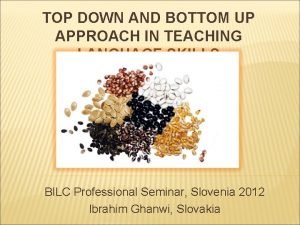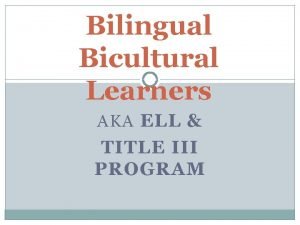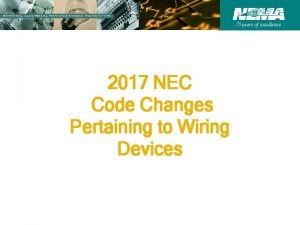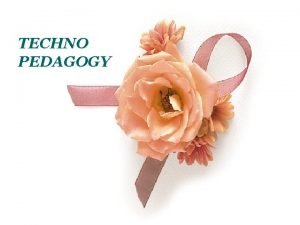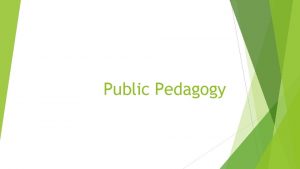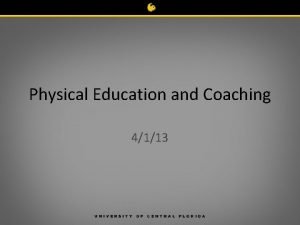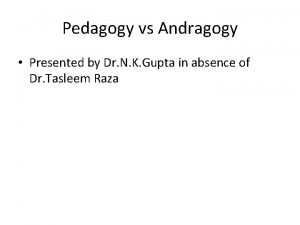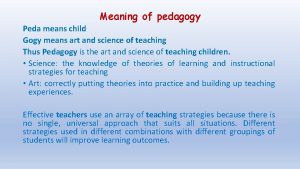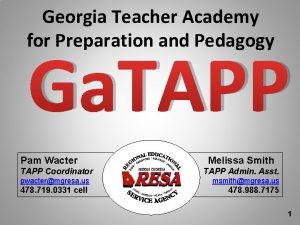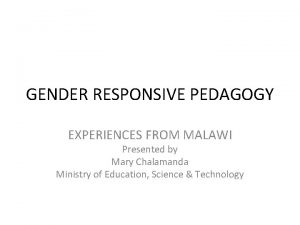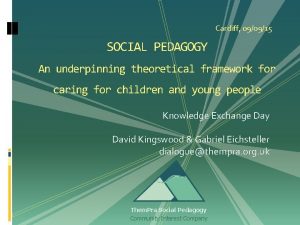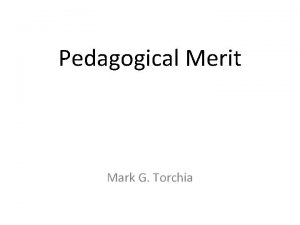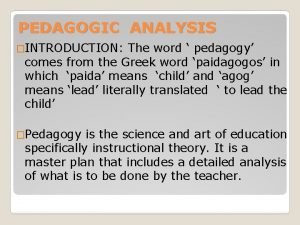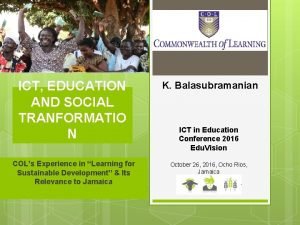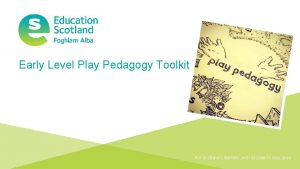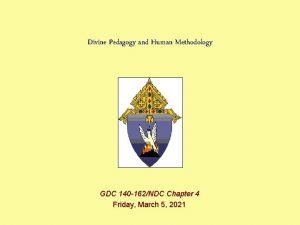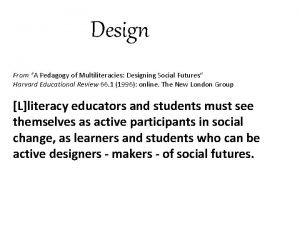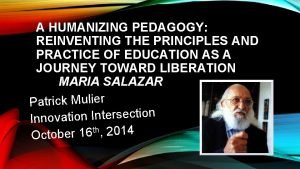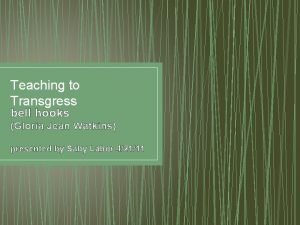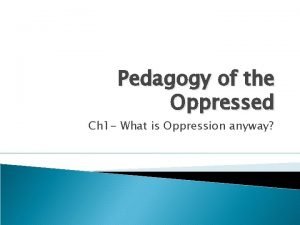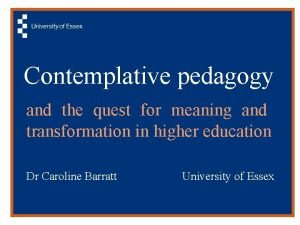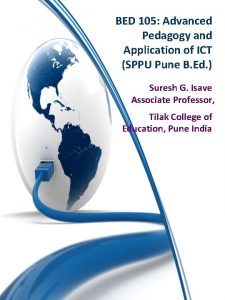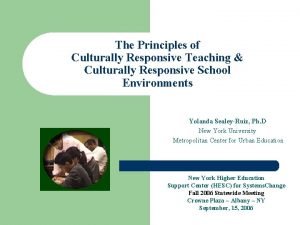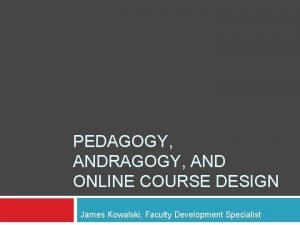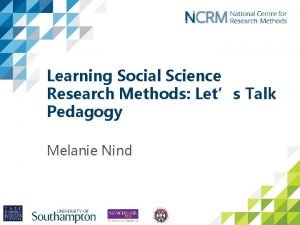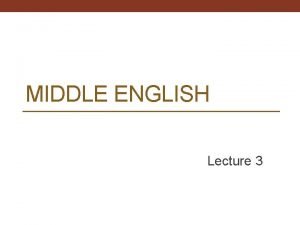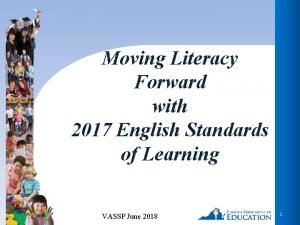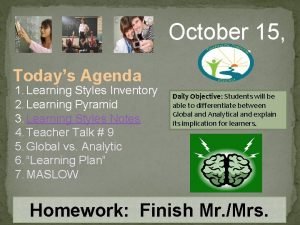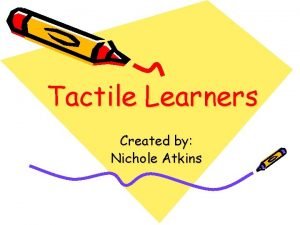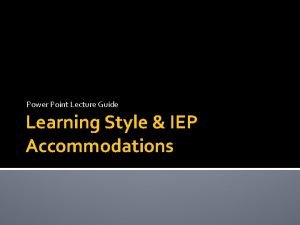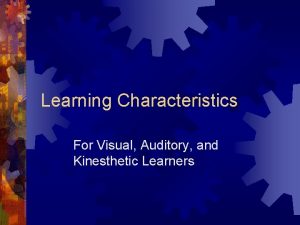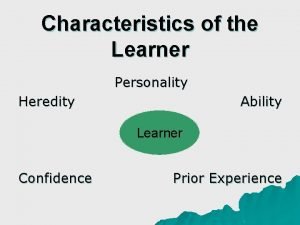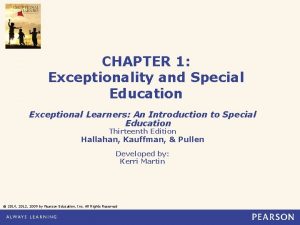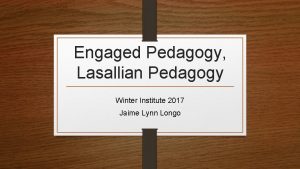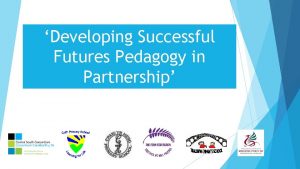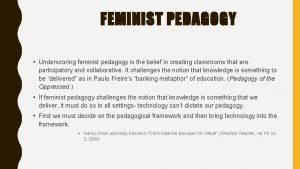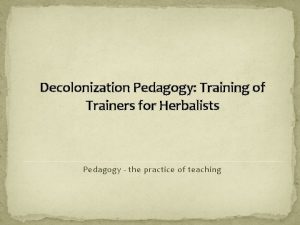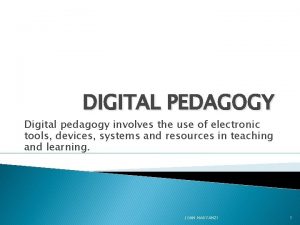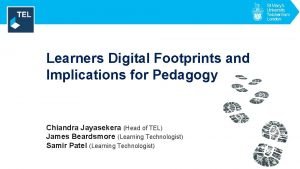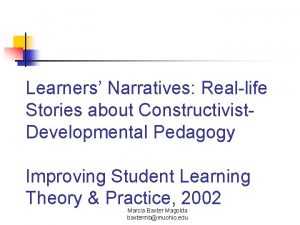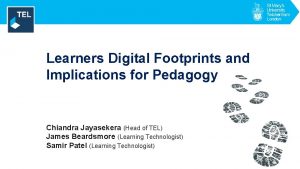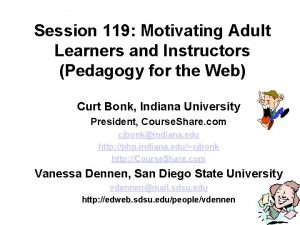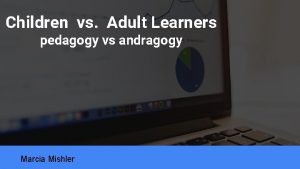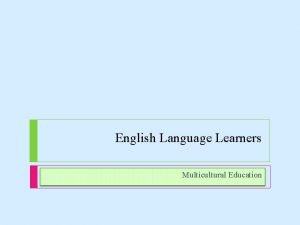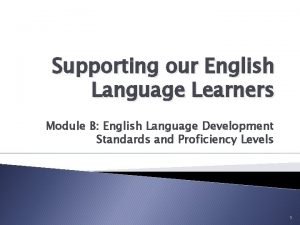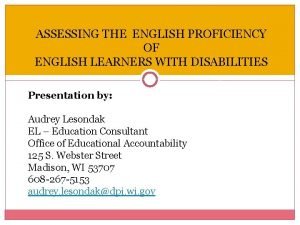Changes in Pedagogy For English Learners 2016 2017
























































- Slides: 56

Changes in Pedagogy For English Learners 2016 - 2017

FWISD e t a R n o i t a u d LEP Gra % 2. 1 6 L EL Eng 1 EOC Distric t ESL 24 . 3%

Grade 6 R eading District % ELL % g n i t i r W 7 e d a r G District % ELL %

Session Objectives • Investigate ways to transform classroom instruction by providing language support and language opportunities for all students, but critical for English Language Learners. • Create a plan of action for campus implementation - next steps in the process to improve outcomes for ELs.

Agenda • Then and Now • PBMAS and TEA • Sociocultural Theory of Learning • Seven Steps • Shifts in Pedagogy • Next Steps

Then and Now… • Think /Write /Pair/Share • Think about your high school days… • What has changed since then? hairstyles, cars, clothing styles, music tastes? • Write down one memorable change on a sticky note. • Share your “memory” with your elbow partner. • Share with your table. • Share a memory from the group using this sentence stem: • We used to ______, but now we_______.

Shifts in Pedagogy http: //www. libertyskids. com/nowthen/index. html


PBMAS

ELs in FWISD • Bilingual Students in DLE • Grades PK-5 • Students at WLI • Students in ESL • ES, MS, HS • Newcomers • Long-Term ELs • Denials • Former ELs (YAE and others)

TEA Visit - Spring 2016 • TEA came in 2008, 2013, 2016… • Our Targeted Improvement Plan (TIP) included a fast-turn around plan for English Learners (ELs. ) • These Seven Steps are the first step in improving instruction for English Learners.

CHANGE

Window Pane

Sociocultural Theory of Learning • Based on the work of Lev Vygotsky • Zones of Proximal Development (ZPD) • In essence – the difference between what one can do without help and what one can do with support from others • Expanded on by the work of Walqui, Van Lier and others






What students can do with assistance today, they will be able to do on their own in the future.

EL Pedagogy – Then and Now From To Seeing language acquisition as an individual process Understanding it as a social process of apprenticeship Conceptualizing language in terms of structures or functions Understanding language as action Seeing language acquisition as linear, progressive process aimed at fluency, accuracy and complexity Understanding that acquisition occurs in non-linear and complex ways Emphasizing discrete structural features Showing how language is purposeful and of language patterned Activities that pre-teach content Activities that scaffold students’ development and autonomy as learners Using simple or simplified texts Using more complex, amplified texts

Improving Instruction for ELs How do we get from here there? From PBMAS Staging student success? We will start with Seven Steps to get to the rigorous, scaffolded instruction with high expectations for improved outcomes for our students.


Seven Steps to a Language-Rich Interactive Classroom 9 Page 1. Teach students what to say when they don’t know what to say. 2. Have students speak in complete sentences. 3. Randomize and rotate when calling on students. 4. Use total response signals. 5. Use visuals and vocabulary strategies that support your objectives. 6. Have students participate in structured conversations. 7. Have students participate in structured reading and writing activities.

11 s e g a P -15 Step One Teach students what to say when they don’t know what to say. This creates an expectation of accountable conversation. IDK

Step One www. dreamstime. com Frustrated teachers, frustrated students… • Better to empower rather than encourage passivity. • If every students is expected to participate, we must provide opportunities for support. • Linguistic accommodations are a part of instruction and accommodation – this helps prepare the learner for asking for clarification and/or assistance.

Step Two page 17 Please speak in complete sentences.

Participation in activity progresses from apprenticeship to appropriation, or from the social to the individual plane.

Step Three page 23 Randomize and rotate when calling on students.

FAQ Responses A possible solution to this question would be to__________.

Participation in activity is central in the development of knowledge.

Step Four Use total response signals. page 29

Table Talk – Chart page 31 • Please stand at your table • Number off 1 -2 -3 -4 • Review Categories: Written response – 1 Ready response – 2 Making Choices – 3 Ranking – 4 • Share at table • Please have a seat when table has finished task.

TIPS 9 8 -9 pp. 9 • Reading Break! • Look at the TIPS in Appendix 3 (Principles for a Language-Rich Interactive Classroom) • Please hold up GREEN CARD when you are ready to GREEN CARD respond to this question: What else can I do to support struggling learners?

Step Five Page 35 Use visuals and vocabulary strategies that support your objectives.

ELPS Quadrant Content Objective Language Objective Vocabulary Sentence Stems

ELPS Quadrant Content Objective 3. 2 Number and operations. The student applies mathematical process standards to represent and compare whole numbers and understand relationships related to place value. Vocabulary represent compare whole numbers place value Language Objective 3 D – Speak using grade level vocabulary in context Sentence Stems When I compare whole numbers, I _____. I use the symbol ____ to represent ____.

Step Six Have students participate in structured conversations. page 43 www. dreamstime. com

QSSSA (Q -Triple S - A) • Question • Signal • Stem • Share • Assess 4 page 4

Learning can be observed as changes in participation over time.

Step Seven page 49 Have students participate in structured reading and writing activities.

Structured Reading • Cornell Notes • Idea Bookmark page 51

Structured Writing - RAFT • Role - Blue • Audience - Hot Pink • Format - Yellow • Topic - Purple page 52

Why Seven Steps? • Change is difficult for most of us. • A simple plan of action is doable. • These steps are already part of the FWISD repertoire. • These seven steps are also easily monitored. • If implemented well, student language practice opportunities will increase. • These Seven Steps are the foundation to the deeper teaching and learning pedagogy we hope to implement in the district in the years to come.

EL Pedagogy – Then and Now From To Seeing language acquisition as an individual process Understanding it as a social process of apprenticeship

EL Pedagogy – Then and Now From To Conceptualizing Understanding language in terms of language as action structures or functions

EL Pedagogy – Then and Now From To Seeing language Understanding that acquisition as linear, acquisition occurs in progressive process non-linear and aimed at fluency, complex ways accuracy and complexity

EL Pedagogy – Then and Now From To Emphasizing Showing how discrete structural language is features of language purposeful and patterned

EL Pedagogy – Then and Now From To Activities that pre- Activities that teach content scaffold students’ development and autonomy as learners

EL Pedagogy – Then and Now From To Using simple Using or simplified complex, texts amplified texts

EL Pedagogy – Then and Now From To Seeing language acquisition as an individual process Understanding it as a social process of apprenticeship Conceptualizing language in terms of structures or functions Understanding language as action Seeing language acquisition as linear, progressive process aimed at fluency, accuracy and complexity Understanding that acquisition occurs in non-linear and complex ways Emphasizing discrete structural features Showing how language is purposeful and of language patterned Activities that pre-teach content Activities that scaffold students’ development and autonomy as learners Using simple or simplified texts Using more complex, amplified texts

Questions?

Next Steps How will I share this information with my campus?

Session Objectives • Investigate ways to transform classroom instruction by providing language support and language opportunities for all students, but critical for English Language Learners. • Knock on the table if we met the first objective. • Create a plan of action for implementation - next steps in the process to improve outcomes for ELs. • Give a “round” of applause if you completed your next steps work.

Reflective Survey Please leave the survey in the center of the table or hand it to one of us as you are leaving. 1. The content presented today successfully met the following learning objectives: Investigate ways to transform classroom instruction by providing better supports and language opportunities for all students – critical for English Language Learners. Not at all O O O To a great extent Create a plan of action for campus implementation. Not at all O O O To a great extent 2. The delivery of content allowed for audience participation and application time. Not at all O O O To a great extent 3. The logistics of today’s learning met the needs of the participants involved. Not at all O O O To a great extent 4. Discussing____________________ made me consider…

Contact Information Bilingual/ESL Department DLE - 817 -814 -2411 ESL - 817 -814 -2413
 Top-down and bottom-up approach in language teaching
Top-down and bottom-up approach in language teaching Language tools
Language tools English language learners
English language learners Teaching young learners english
Teaching young learners english Reading strategies for english language learners
Reading strategies for english language learners Cr part 154
Cr part 154 Changes in latitudes, changes in attitudes meaning
Changes in latitudes, changes in attitudes meaning Ano ang chemical change
Ano ang chemical change Nec article 406
Nec article 406 Irmer 2017 changes
Irmer 2017 changes Techno pedagogy
Techno pedagogy Public pedagogy definition
Public pedagogy definition Sport pedagogy definition
Sport pedagogy definition Pedagogies meaning
Pedagogies meaning Pedagogy literally means
Pedagogy literally means Example of equity pedagogy
Example of equity pedagogy Tapp teacher certification
Tapp teacher certification Gender responsive pedagogy
Gender responsive pedagogy Maria__090915
Maria__090915 How to pronounce merit
How to pronounce merit Pedagogy comes from the greek word
Pedagogy comes from the greek word Gradual release of responsibility pedagogy
Gradual release of responsibility pedagogy Paradigm shift from pedagogy to andragogy to heutagogy ppt
Paradigm shift from pedagogy to andragogy to heutagogy ppt Education scotland play pedagogy toolkit
Education scotland play pedagogy toolkit Divine pedagogy
Divine pedagogy Blogspot
Blogspot Humanising pedagogy
Humanising pedagogy Bell hooks transgression
Bell hooks transgression River
River Contemplative pedagogy
Contemplative pedagogy Advanced pedagogy and application of ict book pdf
Advanced pedagogy and application of ict book pdf Humanising pedagogy meaning
Humanising pedagogy meaning Epistemology and pedagogy
Epistemology and pedagogy Pedagogy meaning
Pedagogy meaning Andragogy meaning in kannada
Andragogy meaning in kannada Pedagogy definition
Pedagogy definition Learner centered pedagogy
Learner centered pedagogy Diamond model social pedagogy
Diamond model social pedagogy Middle english grammar
Middle english grammar Vcaa 2017 english exam
Vcaa 2017 english exam Vce literature unit 1 and 2
Vce literature unit 1 and 2 Staar released essay prompts
Staar released essay prompts Eduqas english language component 1 past papers
Eduqas english language component 1 past papers 2017 english standards of learning curriculum framework
2017 english standards of learning curriculum framework Global vs analytical learners
Global vs analytical learners Teaching grammar to young learners
Teaching grammar to young learners Tactile learner definition
Tactile learner definition Conclusion of remedial teaching
Conclusion of remedial teaching Global vs analytical learners
Global vs analytical learners Visual learners characteristics
Visual learners characteristics Eager learning algorithm
Eager learning algorithm Revision techniques for kinesthetic learners
Revision techniques for kinesthetic learners When is cognitivism beneficial for learners
When is cognitivism beneficial for learners Global analytic continuum
Global analytic continuum The teacher and the profession article iv
The teacher and the profession article iv Characteristic of learners
Characteristic of learners Exceptional learners: an introduction to special education
Exceptional learners: an introduction to special education
